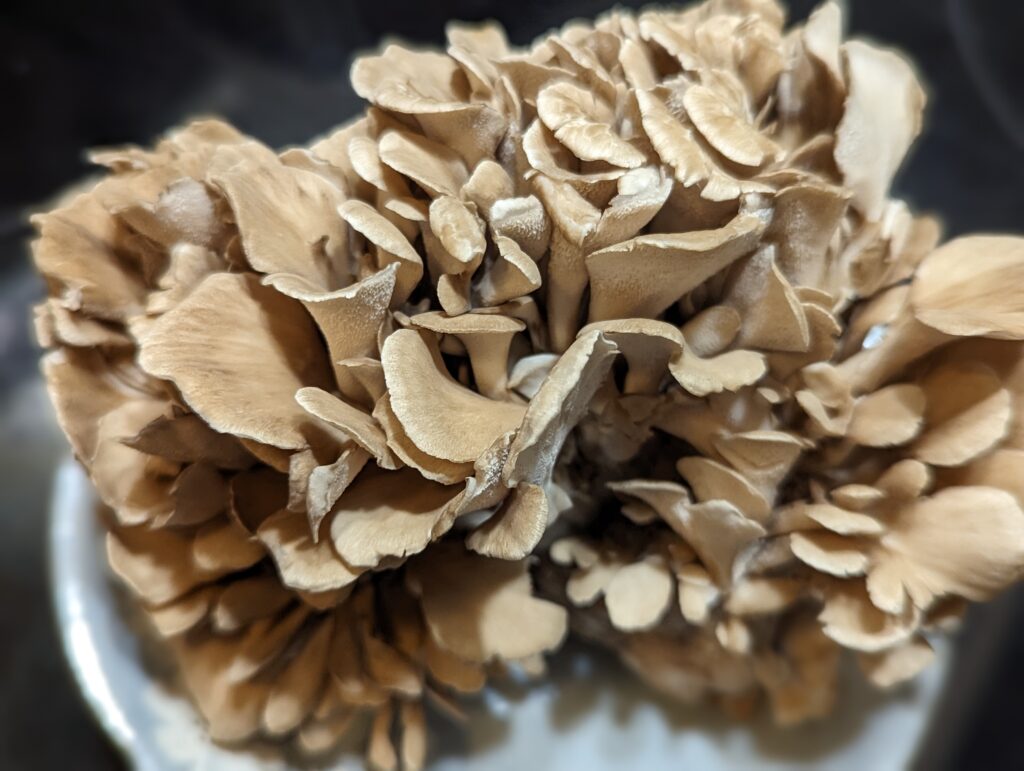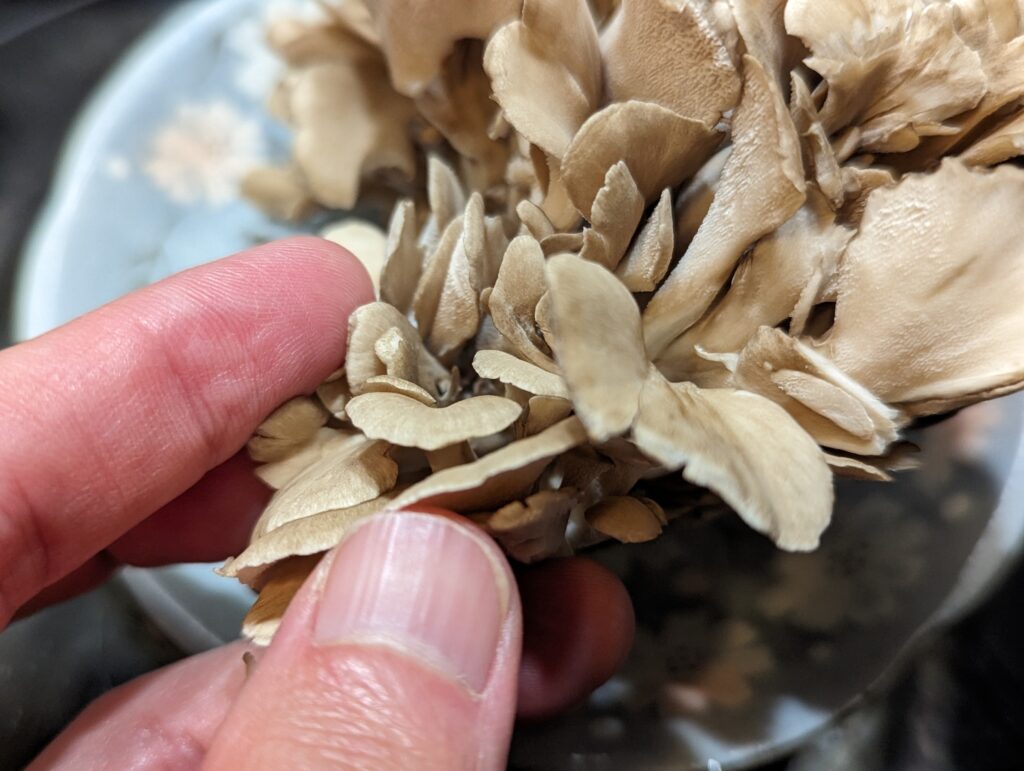- Latin: Grifola frondosa
- Japanese: Maitake 舞茸
- Mandarin Chinese / Chinese Medicinal: Huishuhua 灰樹花
- Minnan Chinese: Danggo 重菇, Lienhuego 蓮花菇
- Hebei Chinese: Limo 栗蘑
- Sichuan Chinese: Qianfojun 千佛菌
- Beijing Chinese: Tianguaban 甜瓜板
- Korean: 잎새버섯 Ipsae Beoseot 葉菌
- English: Hen-of-the-woods
- French: Poule des bois
- Dutch: Eikhaas
- German: Gemeiner Klapperschwamm
What is Maitake 舞茸?
Maitake is a perennial polypore mushroom native to the temperate zone of the Eurasian continent. It grows at the base of trees and fruits from late summer right into autumn. It has a mostly grayish appearance and grows in a cluster with many spoon-like caps with limited tubes. Maitake is entirely edible and a young fruit tastes tender than an older one.

The History and Etyomologiy of Maitake 舞茸
The Chinese Internet claims that the earliest record of Maitake was in the world’s first mycology book written in 1204 by Chen Renyü 陈仁玉 called “Jünpu” 菌谱. This is absolutely untrue. While it is true that Maitake has been plucked and eaten by populations in what is today’s China for millennia, the extremely diverse names show that no intellectuals have actually taken notice of it compared to other forms of edible mushrooms. The current Mandarin Chinese name of Maitake is “Huishuhua” 灰樹花, which means “Grey Treeflower“, referring to its multi-petaled appearance. The name is first used in its written form, following traditional Chinese medicine’s appellation, in “The Fungi of China” 中国的真菌 from Deng Shuqün 邓叔群 only in 1963.
The Japanese name “Maitake” 舞茸 literally means “dancing mushroom“, and has been consistently used since its first written record. It is said that one would dance in intoxication if one eats a raw Maitake.
The first known mention of Maitake was in the “Japanese Materia Medica” (大和本草 Yamato honzō) published in 1709 by Kaibara Ekken 貝原益軒 (1630-1714), Japanese philosopher and botanist. It was next seen in the first Japanese mycology record called “Onkosai Kinbu” 温故斎菌譜 written by Satō Seiyū 佐藤成裕/佐藤中陵 (1762-1848). There, the Kanji characters were written as “舞太计” – a phonic representation of the Japanese name for mushroom, たけ “také“. The medicinal and health properties of Maitake were only described in the Mycology Reference “Xunpu” 菌譜 published by Sakamoto Konen 坂本浩然/坂本浩雪 (1800-1853) in 1834. During the Second World War, Japanese mycologist Yoshio Kobayashi 小林義雄 (1907-1993) spent six years in Manchuria exploring edible mushrooms. He included a detailed description of Maitake in his study on Sino-Japanese mycology 日本中国菌類歴史と民俗学 published later in 1983.
The real appreciation on Maitake 舞茸 in Japan really only took after after the Second World War. It was noticed that Maitake 舞茸 had a positive anti-carcinogenic effect in cancer sufferers in the aftermath of the atomic bombs on Hirokshima and Nagasaki. The legendary reputation of the medicinal properties of Maitake grew further when novelist Tatsuya Kumagai 熊谷达也 (1958-) described a scene in his book “Kaikō no mori” 邂逅の森 how in 1603 after conquering the whole of Japan, Shogun Tokugawa Ieyasu 徳川 家康 fell ill and died from the toils of wars. It was after consuming wild Maitake that he was brought back to life.
In Europe however, though abundant, Maitake was not eaten or valued. Its common English name “Hen-of-the-woods” and its Dutch name “Eikhaas” (literally ‘Oak Hare‘) refer more to its appearance than its properties. Its current scientific name “Grifola frondosa” was described in “A Natural Arrangement of British Plants” published in 1821. The name alludes to the Griffin, which is a mythical half-eagle half-lion animal.



What are the health properties of Maitake 舞茸?
It was only in the 1980s that scientists in Japan took a serious notice of the miracle mushroom. They found that the Maitake was more potent than all other mushrooms traditionally used in East Asian medicine like the Shiitake, Suehirotake or Kawaratake/Lingzhi.
Extremely rich in Vitamin D
Compared to other mushrooms, Maitake loves the sun. Mushrooms all contain ergosterol which helps them to produce Vitamin D. But Maitake, especially wild ones, are far higher than Vitamin D than any other mushroom. On average, a 85g serving of Maitake provides you with up to 955 IU of Vitamin D. The recommended daily amount for those between 1 and 70 years old is 600 IU and 800 IU for those over 70.
Bioactive polysaccharides like D-fraction
The Maitake 舞茸 is also full of bioactive protein polysaccharides, and especially D-fraction, MD-fraction, and SX-fraction. These polysaccharides protect your immune system and help fight tumours. The potency of Maitake’s polysaccharides in vitro reached 16.5 times that of the Lingzhi 灵芝 (Ganoderma sichuanense) a well-known and highly prized mushroom.
Other elements
The Maitake 舞茸 likewise contains beta glucan, Niacin, Riboflavin, Phosphorus and Potassium. Beta glucan help reduce cholesterol and improve the overall artery functions and cardiovascular health.



What has Maitake 舞茸 been researched for?
It is not the intention of the article to provide medical advice. Please refer to your doctor or medical professional for their advice. I would only want to share with you the types of medical trials that Maitake has been used:
- Cancer treatment
- HIV treatment
- Diabetes
- Heart conditions
The Rare Wild White Maitake
As described, Maitake is grey in colour. There is however, a white maitake variety that is extremely rare.
In a 2nd century AD Chinese book entitled “The Book of the Utmost Magical Mushrooms and Herbs” 太上灵宝芝草品, there is a description of what could be the white Maitake, which was called “Baiyüzhi” 白玉芝 (translated as “White Jade Mushroom“):
“白玉芝,生於方丈山中,其味辛,白蓋四重,下一重上,有二枚生,並有三枚生上重,或生大石之上、黄沙之中、腐木之根、高樹之下、名山之陰。得而食之,仙矣。白虎守之。”
“The White Jade Mushroom grows on mountains ten of thousands of feet high. It tastes pungent and has four layers, the lower layers have two stems and the upper layers have three stems. It grows on big rocks, in yellow sands, on rotten roots, under tall trees and in the shade of magnificent mountains. If you find it and eat it, you will become an immortal. It is guarded by the white tiger.”
Sounds like the stuff of legend? Well, the wild White Maitake does exist. Known as the Snow-white Sakura Maitake 櫻花雪茸, or Snow Maitake 雪舞茸, it normally grows at an altitude of more than 1500m at a constant temperature of 16 degrees Celsius. However, with the advancement in technology, the white Maitake has successfully been cultivated and commercialised. It is however not easily available outside of East Asia.
How do you cook Maitake?
You can eat the whole fruit including the stem. It is best to choose the smaller and younger Maitake so that texture remains tender. Make sure that you cook your Maitake fully and completely before consumption.
I love to add it to my hotpot, in addition to other mushrooms like shiitake. I also like to fry it as a tempura, since you can separate it by stems.
I also cook it Chinese Yunnan style in a mushroom soup with other Chinese herbs such as Goji berries and Ginseng.
Of course, you can always combine it with other mushrooms to make a hearty creamy of mushroom soup.
